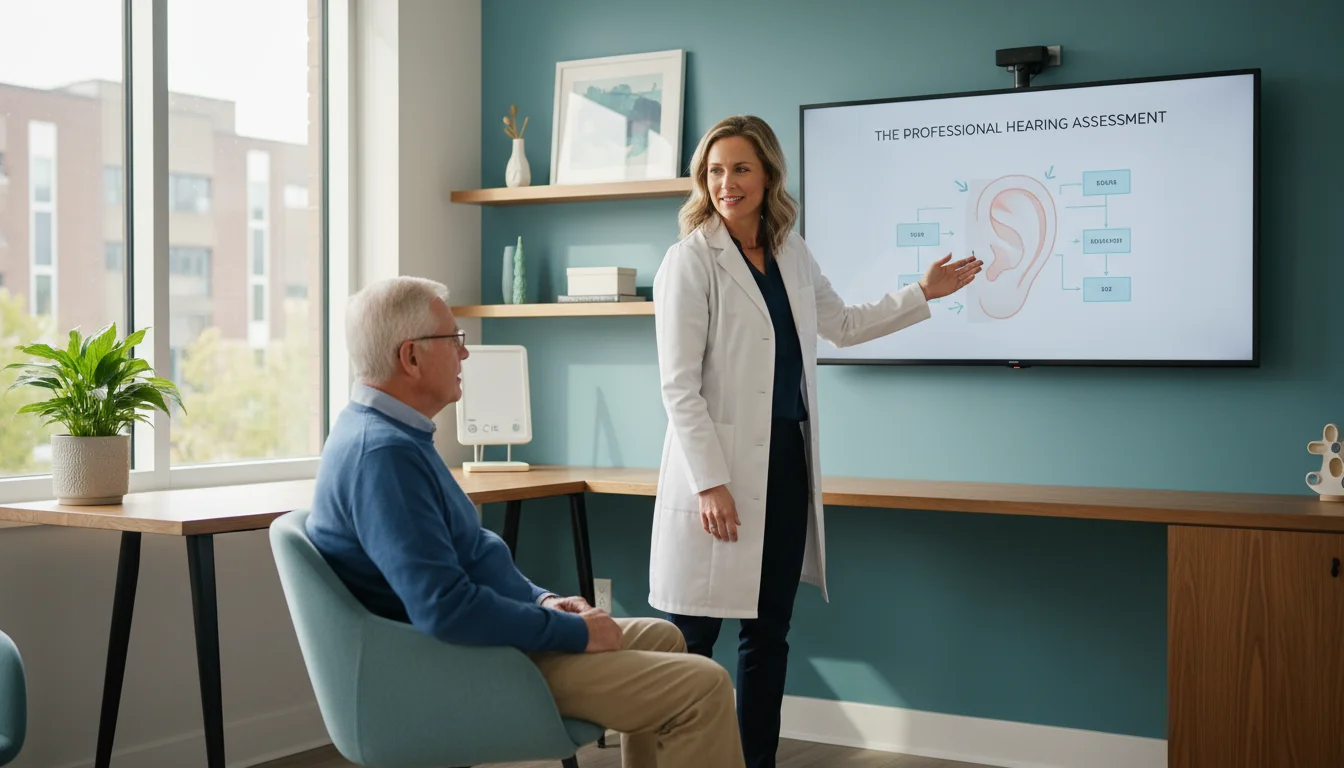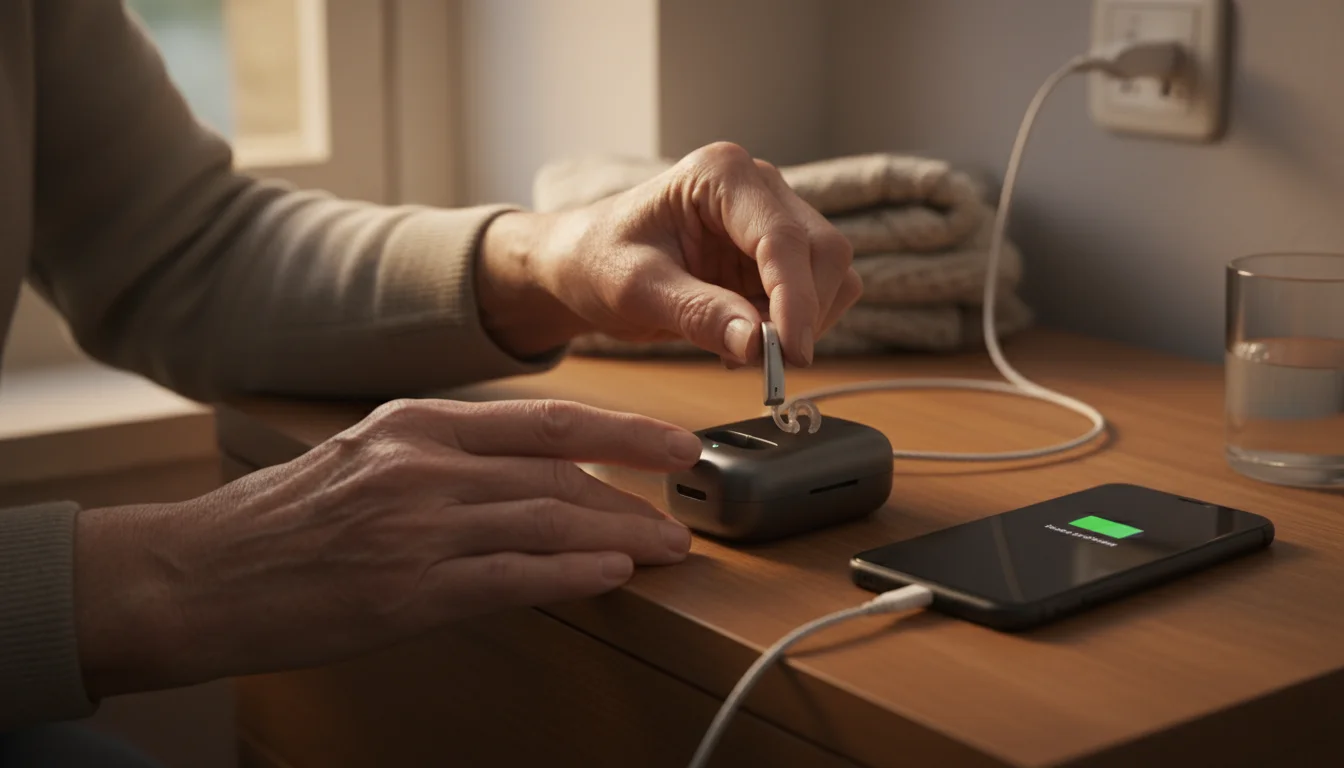
As we journey through life, our bodies change, and that includes our hearing. Noticing that sounds are quieter or conversations are harder to follow is a very common experience for seniors. If this sounds familiar, please know you are not alone, and there is a clear, manageable path forward. Taking steps to address hearing loss isn’t about admitting a weakness; it’s about making a powerful choice to stay connected to your family, your friends, and the world around you.
Think of this guide as a trusted friend taking your hand and walking you through the entire process, one step at a time. We will explore how to recognize the first signs of hearing loss, understand the importance of a professional evaluation, discover modern hearing aid options, and learn how to successfully adapt to a new world of sound. Your journey to better hearing and a richer life starts right here.

Part 1: Understanding and Acknowledging Hearing Loss
The very first step in any health journey is awareness. Sometimes, hearing loss happens so gradually that we barely notice it. We might blame others for mumbling or simply avoid noisy restaurants without realizing why. Acknowledging that your hearing may have changed is the most empowering thing you can do for your overall well-being.
Why this step is important: Untreated hearing loss is more than just an inconvenience. It can lead to feelings of isolation and frustration when you can’t participate fully in conversations. Research has also shown a strong link between untreated hearing loss and cognitive health. Furthermore, your safety can be affected if you don’t hear a smoke alarm, a car horn, or a warning shout. Recognizing the signs is the first step to protecting your health and independence.
How to do a gentle self-check:
Take a moment to honestly reflect on these questions. There is no judgment here, only information to help you move forward.
- Do you frequently ask people to repeat themselves? Does it feel like you can hear but can’t quite understand the words?
- Do family members complain that the television or radio is too loud? You may be turning it up to a level that feels normal to you but is loud for others.
- Do you have difficulty following conversations in groups or noisy places? Places like restaurants, family gatherings, or public halls can be particularly challenging as your brain struggles to filter out background noise.
- Do you feel that other people are mumbling or not speaking clearly? This is a classic sign of high-frequency hearing loss, where you miss the crisp consonant sounds that make speech clear.
- Do you find yourself withdrawing from social situations you once enjoyed? If you feel tired or stressed from the effort of trying to hear, you might start avoiding those situations altogether.
- Do you experience a ringing, buzzing, or hissing sound in your ears? This is known as tinnitus, and it often accompanies hearing loss.
If you answered “yes” to one or more of these questions, it is a strong signal that it’s time to take the next step: seeking a professional opinion. This is a positive and proactive move toward improving your quality of life.

Part 2: The First and Most Important Step – Getting a Professional Hearing Test
While a self-check is a great start, it cannot replace a professional evaluation. You wouldn’t prescribe your own eyeglasses, and the same care should be taken with your hearing. A thorough hearing test is the only way to understand the exact nature of your hearing impairment and rule out any underlying medical issues.
Why this step is important: A professional test is essential for your safety and for getting effective treatment. Sometimes, hearing loss is caused by something simple and reversible, like a buildup of earwax, an infection, or a side effect of medication. An expert can identify these issues. If it is a more permanent hearing loss, the test will create a detailed map of your hearing ability, which is critical for finding the right solution.
How to get a professional hearing test:
- Start with Your Primary Care Physician (PCP). Your family doctor is the best starting point. They can examine your ears for blockages or signs of infection. They can also review your medications and provide a referral to a specialist, which is often required by insurance.
- Find the Right Hearing Health Professional. Your PCP will likely refer you to an audiologist. An audiologist holds a master’s or doctoral degree and is an expert in diagnosing, treating, and managing hearing and balance disorders. They can perform comprehensive tests and help you explore all your options, including hearing aids.
- Prepare for Your Appointment. Think about the situations where you have the most trouble hearing and make a list. Also, bring a list of your current medications. It can be very helpful to bring a spouse or trusted family member with you. They can help you remember information and provide their perspective on your hearing challenges.
- Know What to Expect During the Exam. A hearing test is completely painless and straightforward. You will sit in a quiet, sound-treated room wearing headphones. The audiologist will play a series of tones at different pitches and volumes, and you will signal when you hear one. You may also be asked to repeat words spoken at different volumes to test your speech discrimination.
- Understand Your Results (The Audiogram). After the test, the audiologist will show you an audiogram. This is simply a graph that shows the softest sounds you can hear at different pitches (from low to high). They will explain what it means in simple terms, identifying the type and degree of your hearing loss (e.g., “mild, high-frequency hearing loss”). This graph becomes the blueprint for programming hearing aids to your exact needs.

Part 3: Exploring Your Hearing Aid Options and Solutions
If your audiologist confirms a hearing loss and recommends hearing aids, you may be surprised by the incredible technology available today. Gone are the days of large, whistling devices. Modern hearing aids are tiny, sophisticated computers designed to improve your hearing clarity, comfort, and connection to the world.
Why this step is important: Choosing the right hearing solution is a partnership between you and your audiologist. The goal is to find a device that not only addresses your specific hearing loss pattern but also fits your lifestyle, manual dexterity, and budget. An informed choice leads to greater success and satisfaction.

Understanding Different Hearing Aid Styles
Your audiologist will recommend a style based on your hearing loss and the physical shape of your ear. Here are the most common types:
- Behind-the-Ear (BTE): This is a very popular and versatile style. A small plastic case sits behind your ear, and a clear tube connects to a custom earmold or a soft tip that sits in your ear canal. They are a great choice for almost all types of hearing loss, are generally more powerful, and are easier to handle for those with dexterity challenges.
- In-the-Ear (ITE): These hearing aids fill the outer part of your ear bowl. They are custom-molded to fit your ear, making them secure and comfortable. They are easier to handle than the smaller canal models and have features like volume controls and directional microphones.
- In-the-Canal (ITC) and Completely-in-Canal (CIC): These are smaller, more discreet options that are placed partially or completely inside your ear canal. They are less visible, but their small size means smaller batteries, fewer features, and they can be more challenging to handle. They are best for mild to moderate hearing loss.

Key Features to Consider in Modern Hearing Aids
Today’s technology is truly amazing. Discuss these features with your audiologist:
- Rechargeable Batteries: Many new models come with rechargeable batteries. You simply place them in a charger overnight, just like a smartphone, eliminating the need to handle tiny batteries.
- Bluetooth Connectivity: This is a game-changing feature. You can stream phone calls, music, podcasts, and even TV audio directly to your hearing aids. This provides crystal-clear sound without needing to turn up the volume for everyone else.
- Advanced Noise Reduction: Sophisticated algorithms can identify and turn down background noise while focusing on and amplifying the speech in front of you. This makes conversations in challenging environments much easier.
- Telecoils (T-coils): A telecoil is a small copper wire inside the hearing aid that can pick up magnetic signals. Many public venues like theaters, airports, and houses of worship have “hearing loops” installed. With a t-coil, you can switch to that setting and hear the audio broadcast directly in your ears, cutting out all background noise.

A Note on Over-the-Counter (OTC) Hearing Aids
You may have seen new hearing aids available for purchase directly online or in stores without a prescription. These are intended for adults with perceived mild to moderate hearing loss. While they offer a more accessible option, it is highly recommended to get a professional evaluation first. An audiologist can confirm that an OTC device is appropriate for you and, most importantly, rule out any medical conditions that need a doctor’s attention.

Part 4: The Journey of Adapting to Hearing Aids
Receiving your new hearing aids is an exciting day, but it’s the beginning of a journey, not the finish line. Your brain has grown accustomed to a quieter world, and it needs time to re-learn how to process all the new sounds you’ll be hearing. Patience and a positive attitude are your best tools for success.
Why this step is important: Expecting an instant, perfect fix can lead to disappointment. Understanding that there is an adaptation period helps you set realistic expectations and stick with the process. Consistent use is the key to training your brain and getting the most benefit from your investment in senior hearing health.
Your step-by-step plan for adaptation:
- Start Slow and Quiet. For the first few days, wear your hearing aids for just a few hours at a time in the quiet of your own home. Listen to the clock ticking, the refrigerator humming, or your own footsteps. These are sounds your brain has been missing.
- Practice One-on-One Conversations. Once you’re comfortable with quiet sounds, have a conversation with one other person. Ask them to speak at a normal pace and volume. This helps your brain focus on speech without distractions.
- Gradually Increase Your Wearing Time. Each day, try to wear your hearing aids for a little bit longer. Work your way up to wearing them all day, from the time you wake up until you go to bed.
- Re-introduce Complex Sound Environments. After a week or two, you can try more challenging situations. Watch television at a normal volume. Then, try a small, quiet coffee shop. Work your way up to busier places like a grocery store or a small family dinner. Be patient with yourself.
- Attend Your Follow-Up Appointments. Your audiologist will schedule follow-up visits to check your progress and make fine-tuning adjustments. Be prepared to tell them what sounds good, what is too loud, or if you’re having trouble in specific situations. These adjustments are a normal and essential part of the process.
- Learn to Care for Your Devices. Ask your audiologist to show you how to clean your hearing aids daily and store them safely. Proper care ensures they perform their best and last for many years.

Part 5: Beyond Hearing Aids – Strategies for Managing Hearing Impairment
Hearing aids are a powerful tool, but they are part of a larger strategy for managing hearing impairment. Simple communication tactics and other assistive devices can make a huge difference in your daily life and reduce the strain of listening.
Why this is important: Empowering yourself with communication strategies makes conversations less stressful and more enjoyable for everyone involved. It puts you in control and helps your friends and family understand how best to support you.

Communication Tactics for You:
- Be Your Own Advocate. Don’t be afraid to tell people what you need. A simple, “Could you please face me when you speak? It helps me a lot,” can work wonders.
- Position Yourself for Success. In restaurants or at parties, try to sit with your back to the wall. This reduces the amount of background noise coming from behind you.
- Reduce Competing Noise. At home, turn off the TV or radio when someone is trying to have a conversation with you.

Tips to Share with Family and Friends:
- Get my attention first. Please say my name before you start speaking so I know to listen.
- Face me and speak clearly. Visual cues from your lips and face help me understand.
- Don’t shout. Shouting can distort the sound and actually make it harder to understand through hearing aids. A normal, clear voice is best.
- Rephrase, don’t just repeat. If I don’t understand something, try saying it in a different way instead of repeating the same words louder.

Conclusion: Embrace the Sounds of Life
Taking action on your hearing health is one of the most loving things you can do for yourself and for those who care about you. This journey—from acknowledging a change to getting a test and adapting to new solutions—is a proactive step toward a more vibrant, engaged, and safer life. It allows you to fully participate in family jokes, hear the laughter of a grandchild, enjoy music, and feel confident in your daily activities.
Be patient and kind to yourself through this process. You are not just managing hearing impairment; you are choosing connection, clarity, and well-being. You are choosing to embrace all the beautiful sounds life has to offer.
For expert guidance on senior health and finance, visit AARP, Alzheimer’s Association, American Heart Association and Benefits.gov.
|
Fact-Checked Content
Our editorial team reviews all content for accuracy and updates it regularly. Learn about our editorial process →
|


















